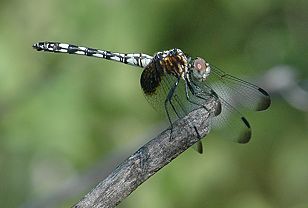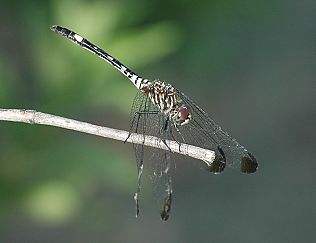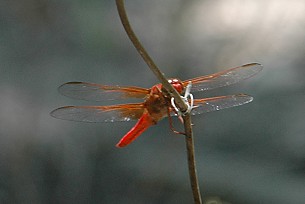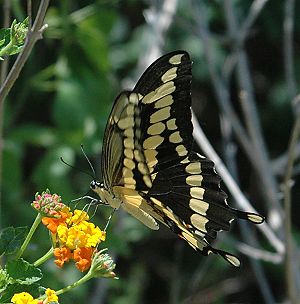
New Photos
June 11, 2006
 |
 |
| Two young female setwings show the similarities and differences in these two species. At this stage, both have white faces, eyes red-brown on top and blue-gray on the bottom, stripes on the thorax, and black and white markings on the abdomen. The checkered setwing, Dythemis fugax, has much more white on the abdomen, as well as dark spots on the wing bases. The swift setwing, Dythemis velox, has clear wings except at the tips, and more black on the abdomen--and will be even darker in a few days. Both were perching on dead twigs a long way from water--one near Fox Pavilion, and one in the horse lot. | |
 |
 |
| This young band-winged dragonlet, Erythrodiplax umbrata, hasn't yet darkened to the adult colors: the bands on the wings are blurry, not crisp, a light stripe over the top of the thorax, olive-brown sides of the thorax, and light patches on the side of the abdomen. | Here's the adult form: crisp, solid black bands on the wings, completely dark head and thorax, with a dark blue (almost black in some light) abdomen. |
 |
|
| Male neon skimmers deserve the name: they glow in the light. This species prefers shaded streams; we have them in our water garden because it has a shady section. But this one was patrolling a section of the creek in the shade of the south creek woods. | |
 |
|
| Even though it's now very dry and hot, with big cracks in the ground, the lantana is still blooming, and the occasional giant swallowtail shows up to nectar there. | |
 |
|
| This little amphibian, barely a centimeter long, was one of dozens hopping about on the now-dry bed of Westbrook. I thought it was a tiny cricket frog, but Dr. Pierce, after looking at this picture, said it was probably a baby toad. | |
![]()

